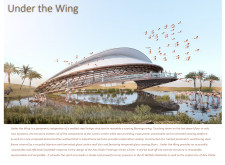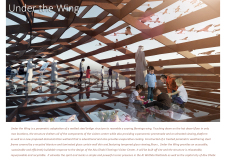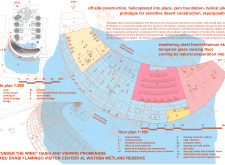5 key facts about this project
Under the Wing is designed to respond to the unique environment of the Al Wathba Wetlands while providing essential facilities for visitors. The project emphasizes a strong connection to nature, drawing inspiration from the form of a flamingo wing. Its design allows for minimal disruption of the desert landscape, blending functionality with a creative aesthetic.
Conceptual Framework
The design emphasizes a parametric approach that reflects organic shapes found in nature. By supporting the structure at just two points on the ground, the building reduces its impact on the environment. This architectural choice creates a sense of lightness and encourages visitors to move fluidly through the space. Each area is connected, guiding visitors effortlessly from entry to exit.
Functional Spaces
Visitors will encounter multiple functional areas designed to enhance their experience. The journey begins in a welcoming reception area, followed by administrative offices and exhibition spaces. Interactive glass floors invite exploration, adding an engaging element. Facilities like a café and gift shop are included to support visitor needs while preserving the overall flow of movement. An outdoor promenade further enriches the visit, providing views of the surrounding wetland.
Material Approach
Materials chosen for the structure play a key role in its design. The main framework is constructed from treated parametric weathering steel, known for its resilience in harsh climates. This is paired with a curtain wall made from recycled titanium and laminated glass, allowing natural light to illuminate the interior. The use of tempered glass in viewing areas helps connect the inside with nature outside.
Environmental Integration
An educational demonstration wetland is integrated into the design, supporting ecological education and awareness. This feature serves as both a learning tool and a method for evaporative cooling, ensuring a comfortable environment for visitors. To promote efficiency, the building is designed to be fabricated off-site. It is relocatable and can be repurposed, highlighting its sustainable approach in adapting to future needs.
The roof shape mimics the arc of a flamingo wing. This design choice contributes to a cohesive visual language that reinforces the building's relationship with its environment while offering visual interest and enhancing the overall experience for visitors.






















































